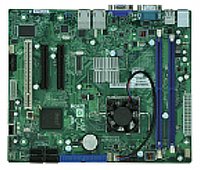Atom makes the leap into servers
May 11, 2009 — by LinuxDevices Staff — from the LinuxDevices Archive — 2 views Super Micro is promoting the use of Intel's Atom processor in servers. The “X7SLA” motherboard is designed to be mounted in a 1U rack (left) or minitower chassis, offers single or dual gigabit Ethernet ports, and includes four SATA ports with RAID support, Super Micro says.
Super Micro is promoting the use of Intel's Atom processor in servers. The “X7SLA” motherboard is designed to be mounted in a 1U rack (left) or minitower chassis, offers single or dual gigabit Ethernet ports, and includes four SATA ports with RAID support, Super Micro says.
(Click here for a larger view of Super Micro's X7SLA in a rackmount case)
Intel released its single-core Atom 230 processor last year, and later followed it up with a dual-core version, the Atom 330. Since that time, various vendors have put these CPUs in low-cost desktop PCs known as “nettops,” but few have incorporated them into servers. San Jose-based Super Micro, however, now suggests that these CPUs, which have TDPs of four Watts and eight Watts, respectively, could be ideal for light-duty servers or storage appliance.
The company's new X7SLA motherboard uses Intel's FlexATX format, which measures 9 x 7.5 inches and is compatible with a multitude of off-the-shelf cases. Super Micro suggests, for example, its SuperChassis 502-200B pictured at the top of our story, which accepts a single 3.5-inch hard disk drive (HDD), dual 2.5-inch HDDs, or a single 2.5-inch HDD and a half-length PCI expansion card.
 However it is housed, the X7SLA (right) comes in two different versions: an “L” variant includes the Atom 230 CPU and a single gigabit Ethernet port, while an “H” version includes the Atom 330 and a second gigabit Ethernet port. Both employ Intel's 945GC northbridge and ICH7R southbridge, and both accept 2GB of DDR2 RAM via dual SODIMM sockets, Super Micro says.
However it is housed, the X7SLA (right) comes in two different versions: an “L” variant includes the Atom 230 CPU and a single gigabit Ethernet port, while an “H” version includes the Atom 330 and a second gigabit Ethernet port. Both employ Intel's 945GC northbridge and ICH7R southbridge, and both accept 2GB of DDR2 RAM via dual SODIMM sockets, Super Micro says.
Both X7SLA versions have four SATA ports, capable of accepting disk drives configured as RAID 0, 1, 5, or 10 storage arrays. Super Micro says both also include VGA ports, EIDE controllers, PS/2 connectors for a keyboard and mouse, and seven USB 2.0 ports (two with rear-panel connectors, and five via pin headers).
The X7SLA boards each have a single 32-bit PCI expansion slot, plus another slot that may be configured as PCI Express x8 or PCI Express x4. The “H” model adds an additional USB port, plus a serial port, according to the company.
Features and specifications released by Super Micro for the X7SLA include:
- Processor — Intel Atom 230 or 330 clocked at 1.6GHz
- Memory — Dual SODIMM sockets accept up to 2GB of DDR2 memory
- Networking — Single (X7SLA-L) or dual (X7SLA-H) gigabit Ethernet ports
- Other I/O:
- 1 x VGA port
- 4 x SATA ports (configurable as RAID 0, 1, 5, 10)
- 7 x USB 2.0 ports (2 rear panel, 5 via headers; X7SLA-H adds additional USB port)
- 1 x serial port and 1 x header (X7SLA-H only)
- 1 x EIDE
- 2 x PS/2
- 1 x VGA port
- Expansion:
- 1 x 32-bit PCI
- 1 x PCI Express x8 or PCI Express x4
- 1 x 32-bit PCI
- Operating temperature (in SuperChassis 502-200B) — 10 to 35 deg. C (50 to 95 deg. F)
- Dimensions:
- 9 x 7.5 inches (board only)
- 17.2 x 9.8 x 1.7 inches (in SuperChassis 502-200B)
- 9 x 7.5 inches (board only)
Availability
Super Micro did not provide information about operating system support for the X7SLA, but judging by the standard Intel processor and chipset, the board should support Linux, Windows XP, Windows XP Embedded, Windows Embedded Standard, and Windows CE, among other x86-compatible operating systems. Availability details were also not disclosed.
This article was originally published on LinuxDevices.com and has been donated to the open source community by QuinStreet Inc. Please visit LinuxToday.com for up-to-date news and articles about Linux and open source.